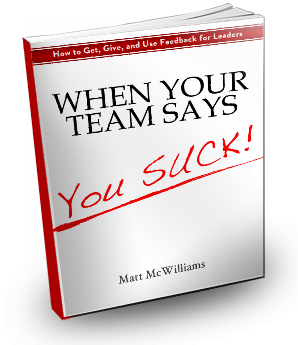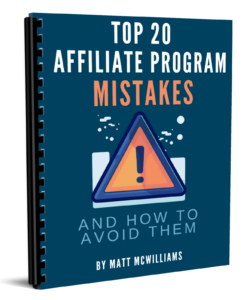I’m going to take a big bite out of the “feedback sandwich.” Mmmm. If you’re not familiar with the “feedback sandwich,” it’s a method popularized by Ken Blanchard and Spencer Johnson in the book, The One Minute Manager. It basically goes like this” Praise first, then correct, then praise again. And I hate it.

Here’s what the “feedback sandwich” often sounds like:
Leader: “I need to correct a behavior or point out something wrong that someone is doing. What should I do? I know…”
Five minutes later…
Leader: “Jim, you are a valuable member of our organization and are doing a bang up job with the new sales reports.”
Jim, thinking to himself and possibly audibly: “But?”
Leader: “What I really need you to work on, though, is your .”
Jim: “Uh, sure. I can work on that.”
Leader: “Great. Thanks. And your hair looks phenomenal today. What are you using in it?”
OK, that last one probably never happens. Right? Or are leaders supposed to compliment their team members on their hair? Just making sure I didn’t miss something.
A lot of people swear by the “feedback sandwich.” People a lot more famous than I am. People I look up to. And don’t get me wrong, The One Minute Manager is a phenomenal book.
But the “feedback sandwich” has one major flaw, the reason why I hate it so much and eschewed it four years ago.
It differentiates positive feedback from corrective feedback.
It comes down to this…the fundamental problem with the feedback sandwich:
It’s used by humans.
Human leaders with emotions. Human leaders with expressive faces. Human leaders who telegraph the true intention of the meeting or feedback from a mile away.
And human recipients on the other end who also have emotions and can tell the leader’s true intentions from a mile away. People know when they are being called to the principal’s office.
Thus…the beginning and the end parts are rarely heard. They are fluff. They are ignored.
Or the middle part is missed. The real reason for the meeting is missed. The very thing that a team member needs to work on the most is overlooked. The opportunity for growth is passed up.

Summary of feedback sandwich flaws
- Humans have emotions.
- Mixing positive and corrective feedback is confusing.
- Important feedback is missed.
A better way…no bread, just meat
About four years ago I started using a simple method of giving positive and corrective (notice I didn’t say “negative”) feedback in the exact same manner. And I told my team what it would look like in advance.

The wrong way (to me at least) was what I did prior to that. Good feedback was delivered with a huge smile and a pat on the back. A big “attaboy” if you will.
Corrective feedback was preceded by an invitation to visit the principal’s office and then a long drawn out, beat around the bush, finally get to the point extravaganza.
So I told my team that from now on it would like look like this:
Positive: “When you do X, here is what happens. Keep it up!”
Corrective: “When you do X, here is what happens. What can you do to change that?”
The format is exactly the same for each of them. Neither was delivered with extreme variance in emotion.
Listen to the audio version for more examples of my feedback method and further insight into this topic.
Why is this feedback method better?
- Because we’re all adults here. And I made sure my team was all wearing their big boy (and girl) pants before I introduced it to them.
- I spent a lot of time giving positive feedback. I practiced the 90/10 rule.. For every one critique or correction, I gave nine positive pieces of feedback. In other words, I spent a lot of time giving positive feedback. I didn’t need to muddle the corrective feedback with fluff.
- They knew I meant it. Whether it was positive or corrective feedback, my team knew I meant it. When I took out the fluff, they knew it was real. Corrective feedback was acted upon and positive feedback made sure they did more of the same.
Feedback is intended for one reason: to cause the desired future behavior, by either reinforcing a good one or correcting a bad one.
It’s best to keep it simple.
What are your views of the feedback sandwich, positive or negative? What better ways have you used?
Questions?
Text me anytime at (260) 217-4619.
Or…check out some of my free reports to help you get on the right track:
 |
 |
 |
 |
 |
 |
 |
 |
 |





I think this “sandwich” feedback comes from the “feel good” generation. Too many people want to feel good about what they are doing without ever really hearing the negative stuff. It’s crap and does nothing toward improvement. I’ve always gotten more if you tell me the issue so I can fix it. Short, sweet, and to the point if you will. Murking up the water does nothing but confuse the issue like you said. Life is made of winners and the others. Winners make history, change policy and create tomorrow’s world. The others are comfortable letting them.
Very well said Steve.
I never thought the connection to the “feel good” generation but the timing of it becoming popular does line up with that.
Thanks for sharing your thoughts. Keep it up!
Agreed Steve. I appreciate being treated like an adult. If we have an issue, lets talk about the issue. At the end of it, you can tell me you appreciate me and I’m doing a great job overall, but don’t sugar coat it by trying to prep me for the bad news!
Appreciate your comment!
OK…you sold me.
Nice!
The bitch sandwich is what I’ve called it for years and it is a big trust destroying activity. It’s false. Inauthentic.
Ken Blanchard and Hersey have blazed leadership trail, and I honor them for it, but I disagree with them that this is a good idea.
I’m not mad at them. Like you said, they’ve blazed a trail. They’ve done 800 things right and a few wrong.
I will say that sandwich feedback is better than no feedback at all, so I can possibly see it empowering a shy leader…silver lining?
I think if it’s recognized as a principle, it works…but if it’s employed as a tactic (which, more often than not, it is…) then its demoralizing and very conterproductive.
Perhaps that’s where Ken was coming from with it?
He probably praises all. the. time. in his organization, so the feedback sandwich doesn’t feel manipulative, but for most leaders who break out the bread, mayonaise and meat only when they’re about to sock someone in the face with their criticisms, it doesn’t work!
Totally see your point. I see why over time people would be suspicious of receiving good feedback. They know “the meat” is coming. I’ll definitely implement “bread meetings” and “meat meetings” moving forward. Thanks, Matt!
That is great news Lily! I’m going to do more audio on this in the future with some more examples and how to introduce it to your team.
I definitely agree with you on this one Matt. Most of the time if you are trying to do the positive-negative-positive, you end up just throwing out some random “positive” thing that you don’t really care about but feel you have to say in order to not hurt someones feelings. I think it is much better to get to the point of what you are trying to say. Less confusion and people will more readily believe what you say in the future.
Amen Paige. You are right in that the positive part is very often just random.
I am right there with you on this one, Matt. in fact, I addressed the same thing in my blog a little over a year ago and called BS on the method.
If performance needs to be corrected, then correct it. Don’t criticize it, and certainly don’t camouflage the issue. Coach by addressing the issue and work to inspire commitment to change.
I think you hit the nail on the head Bill, the feedback sandwich has a tendency to camoflauge the real issue. Either it will come across as completely patronizing to the individual, or they will totally miss what you are correcting and continue doing it!
Ugh…..I was having a conversation with someone (outside of work), and they not only used the feedback sandwich, but actually stated they were going to use the feedback sandwich. “Well, I like to say something good, and then be honest, and then say something good again.” Combine that with the fact that their criticism was “I don’t like it.” and when I asked “Why?”, it was “I don’t know why. I just don’t.” I never had to urge to consult with them again.
Why don’t we use the feedback sandwiches in other places? Wendy’s messed up my order yesterday. Should I give them feedback of, “I ordered, and the wait time was low. But they had put on mayo when I asked for no mayo. When I got home, the fries were nice and hot.” You know what would happen then? They’d think they succeeded. No, it’s a confusing message.
Agreed Bryan, it’s confusing and pretty patronizing. You’re right, it doesn’t accomplish what you’d like it to accomplish. I think it’s good in theory, but it should be used like Matt says, over the course of days and weeks and months, not seconds. Praise someone all the time for days and weeks, correct them when they need to be corrected, then get right back to praising and encouraging them all the time!
This might be the single best description of why it doesn’t work I’ve ever read Bryan. Well said.
And the brevity of your response is good. Had you written a paragraph on why it’s a great explanation, I probably would’ve glanced over section 1 and glanced at the end. Would’ve missed the meat.
And if you put mayo on my feedback sandwich, I really don’t like it.
Bryan, I’ve been following Matt’s blog and your comments brought me out of my shell to comment for the first time.
Hilarious! Keep it up. And thanks @Matt_McWilliams:disqus for the great conversation starter today.
Feel free to follow my blog http://www.logan.cc/blog/ and twitter http://www.twitter.com/BryanMarkLogan
Warning though: I don’t post a ton of leadership stuff, but I do tweet about McDoubles way more than Matt does.
There is a difference between being an editor/critiquing some writing or a project than a fast food sandwich.
I assume you’d have some kind of “ice breaker” such as “hi” or “how are you?” before mentioning the messed up sandwich. Saying “thank you” for when the sandwich is fixed is the other part of the feedback sandwich. I look at a lot of this as common courtesy/customer service. And if you don’t have good customer service–you won’t have long term customers.
Feedback sandwich is defined as: Praise first, then correct. then praise again.
I’m not sure how “hi” constitutes praise.
“Thank you” also isn’t feedback on the original issue, but it’s feedback on the fixing of the issue. You’re not thanking them for messing up your sandwich, you’re thanking them for the correction.
I think it depends on the setting. 80% of the feedback I offered was during a one-on-one meeting.
19% was delivered in context of the situation. In other words, it was a part of a conversation.
The 1% that needs to be delivered right away and isn’t a part of a conversation can be awkward, yes. And it should still be delivered in the context of real life and in private if corrective. In other words, a greeting and a few seconds of stage setting is appropriate. 🙂
James!! Don’t be a stranger!! We don’t bite, I promise! Well, most of us, I can’t vouch for Matt! Keep commenting!
Agreed Matt. I know I always know when i’m going to be corrected…and you’re right, at that point, you just ignore everything you hear before and after the criticism. You’re first bracing for it, and after you’re trying to process it.
I think you’re right that we just need to treat our team members like adults and be straight forward. You don’t have to compliment right before you criticize–compliment all the time, that way they’re in the right frame of mind to accept the criticism.
I wrote about this awhile back when I realized that influence is acquired through respect. If you can get your team to respect you (by always encouraging, uplifting, and helping them) then when you have to correct, you’ll have influence with them and be able to present the criticism in the correct way–and they will accept it likewise.
Thanks for this post! It’s a knockout..as always!
1. Great post
2. You might have made an error in item #3 of the summary – “importation” instead of “important”
3. Nice shirt
P.S. I’ve always thought that the feedback sandwich was made out of Wonderbread with a bit of Miracle Whip and baloney. Phoney, Fakey, Phooey.
1. Thank you.
2. Thank you. Corrected.
3. No joke…you made me check out the images…like “what is so special about the shirt?” Then I got it. Well played.
This is what made me say “Great post”.
1. I LOVE your straightforward way of giving positive feedback.
2. I LOVE your straightforward way of giving corrective feedback.
3. It is more accurate to call it “corrective” rather than “negative”. Correcting the problem should be the point of criticism. Getting caught up in the word “negative” can turn the whole thing into a red herring of “you hurt my feelings”, complete with the pouty face, and maybe even running to someone else to tattle on the “mean boss”, instead of correcting the problem. WHERE ARE THE GROWN-UPS??
I think the feedback sandwich works but only when delivered properly. That’s a tough thing to do and too many leaders fail at it.
Totally agree Matt. I think the confusion comes in because sometimes as leaders we try to be kind instead of loving. Kind white washes so much that it leaves confusion. Love cares and so is very clear so the person has an option weather to go to the desired outcome.
That’s a great way of looking at it. Love is direct. Kind, but direct.